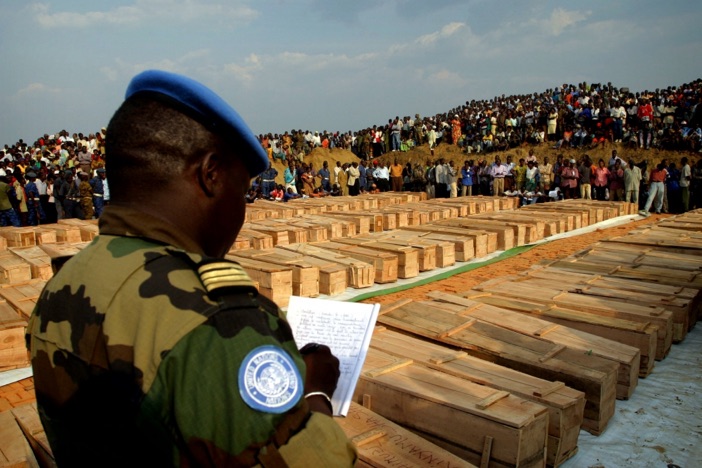What is R2P?
The Responsibility to Protect populations from genocide, war crimes, crimes against humanity and ethnic cleansing has emerged as an important global principle since the adoption of the UN World Summit Outcome Document in 2005.

Responsibility to Protect
The Responsibility to Protect – known as R2P – is an international norm that seeks to ensure that the international community never again fails to halt the mass atrocity crimes of genocide, war crimes, ethnic cleansing and crimes against humanity. The concept emerged in response to the failure of the international community to adequately respond to mass atrocities committed in Rwanda and the former Yugoslavia during the 1990s. The International Committee on Intervention and State Sovereignty developed the concept of R2P during 2001.
The Responsibility to Protect was unanimously adopted in 2005 at the UN World Summit, the largest gathering of Heads of State and Government in history. It is articulated in paragraphs 138 and 139 of the World Summit Outcome Document:
World Summit Outcome Document
138. Each individual State has the responsibility to protect its populations from genocide, war crimes, ethnic cleansing and crimes against humanity. This responsibility entails the prevention of such crimes, including their incitement, through appropriate and necessary means. We accept that responsibility and will act in accordance with it. The international community should, as appropriate, encourage and help States to exercise this responsibility and support the United Nations in establishing an early warning capability.
139. The international community, through the United Nations, also has the responsibility to use appropriate diplomatic, humanitarian and other peaceful means, in accordance with ChaptersVI and VIII of the Charter, to help to protect populations from genocide, war crimes, ethnic cleansing and crimes against humanity. In this context, we are prepared to take collective action, in a timely and decisive manner, through the Security Council, in accordance with the Charter, including Chapter VII, on a case-by-case basis and in cooperation with relevant regional organizations as appropriate, should peaceful means be inadequate and national authorities are manifestly failing to protect their populations from genocide, war crimes, ethnic cleansing and crimes against humanity. We stress the need for the General Assembly to continue consideration of the responsibility to protect populations from genocide, war crimes, ethnic cleansing and crimes against humanity and its implications, bearing in mind the principles of the Charter and international law. We also intend to commit ourselves, as necessary and appropriate, to helping States build capacity to protect their populations from genocide, war crimes, ethnic cleansing and crimes against humanity and to assisting those which are under stress before crises and conflicts break out.
R2P stipulates three pillars of responsibility:
-
1Pillar One
Every state has the Responsibility to Protect its populations from four mass atrocity crimes: genocide, war crimes, crimes against humanity and ethnic cleansing.
-
2Pillar Two
The wider international community has the responsibility to encourage and assist individual states in meeting that responsibility.
-
3Pillar Three
If a state is manifestly failing to protect its populations, the international community must be prepared to take appropriate collective action, in a timely and decisive manner and in accordance with the UN Charter.
R2P Since 2005
In January 2009 the UN Secretary-General released a report on implementing the Responsibility to Protect, which articulated the three pillars of R2P. Following this, the first General Assembly Debate on the Responsibility to Protect was held in July 2009. At this debate UN Member States overwhelmingly reaffirmed the 2005 commitment and the General Assembly passed a consensus resolution (A/RES/63/308) taking note of the Secretary-General’s report.
The Secretary-General has since released annual reports in advance of the UN General Assembly Informal Interactive Dialogue on the Responsibility to Protect. During June 2018 the General Assembly held its first debate on the Responsibility to Protect since 2009.
R2P has been invoked in more than 80 UN Security Council resolutions concerning crises in Central African Republic, Côte d’Ivoire, Democratic Republic of the Congo, Liberia, Libya, Mali, Somalia, South Sudan, Syria, and Yemen, as well as thematic resolutions concerning the prevention of genocide, prevention of armed conflict and restricting the trade of small arms and light weapons. The Responsibility to Protect has also been invoked in more than 50 Human Rights Council resolutions and 13 General Assembly resolutions. These resolutions and their related preventive and – as a last resort – coercive measures, have demonstrated that collective action to protect populations at risk is possible.
Individual states and global networks, such as the Global Network of R2P Focal Points, have undertaken various national initiatives to ensure they are preventing mass atrocity crimes through upholding their pillar I and pillar II commitments.